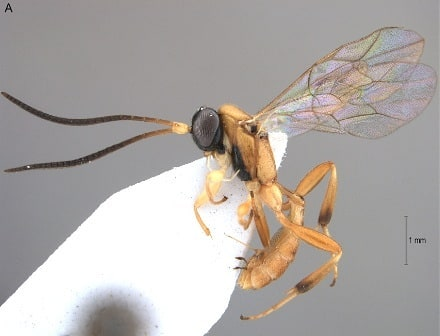撰稿:Alexey Reshchikov 翻译:刘晓雨
Palpostilpnus 属姬蜂的故事始于Alexey Reshchikov在中国工作时从海南岛发现的一个新物种,由此与东南亚发现的九个新物种一起,经过三年的努力和广泛的研究,发现它们的数量多于世界上已知此类物种的一倍。这类姬蜂的特征是触须很长,头短,产卵器细长,呈针状。Palpostilpnus属姬蜂这些特征的生物学属性很神秘,研究认为其产卵器可能是对产卵到早期宿主阶段的适应,它的头部类似于双眼分开的双翅目(如杆蝇科,水蝇科),这被认为可能是某种类型的寄生—宿主拟态。
Palpostilpnus属的栖息地包括山区的林地,包括常绿阔叶林或落叶混交林区域,或是低海拔区的龙脑香林、沼泽和潮间带红树林。此类型的生境都属于脆弱的生态系统,受到的破坏和威胁日益增加,包括间接(全球变暖和其他环境影响)和直接(生境破坏)。随着东南亚地区生境丧失的不断加速,且收集到Palpostilpnus属物种大多数都是单一的,表明该属物种为稀有物种。该研究工作将会促进更多相关研究的产生,并希望最终制定出对应的保护策略。也希望该工作能激发人们对环境问题的更多关注,并鼓励人们开展全球范围Palpostilpnus属的研究。

姬蜂属一新种
原文链接:https://europeanjournaloftaxonomy.eu/index.php/ejt/issue/view/691
https://doi.org/10.5852/ejt.2019.582
The Palpostilpnus story began on my job start in China with discovery of single new species from Hainan Island and resulted as three years joined efforts and broad genus review with nine other new species described from Southeast Asia, more than doubling the number of known species worldwide. These wasps can be characterized by a very elongated palps, short head and slender needle-like ovipositor. The biology of Palpostilpnus is enigmatic but we hypothesized that its ovipositor might be an adaptation to oviposit into very early host stages. Its head resembles that of some Diptera with divided eyes (e.g., Chloropidae, Ephydridae). This may be assumed with caution to be a case of some type of parasitoid–host mimicry. The habitats of these wasps are woodlands, either evergreen broadleaved or deciduous mixed forest at mountainous sites, or dipterocarp, swamp or intertidal mangrove forests in the lowlands. These habitats invariably represent fragile ecosystems, which are increasingly under the threat of destruction, either indirectly (global warming, and other environmental impacts) or directly (habitat destruction). In the face of rapid habitat loss in Southeast Asia in general, coupled with the fact that most species collected are singletons, implying a certain level of rarity, we hope that our work will encourage more research and hopefully, down the line the formulation of conservation strategies. Our work can hopefully stimulate extra attention to environmental problems and encourage further studies of the global fauna of Palpostilpnus.
Article links: https://europeanjournaloftaxonomy.eu/index.php/ejt/issue/view/691
https://doi.org/10.5852/ejt.2019.582

